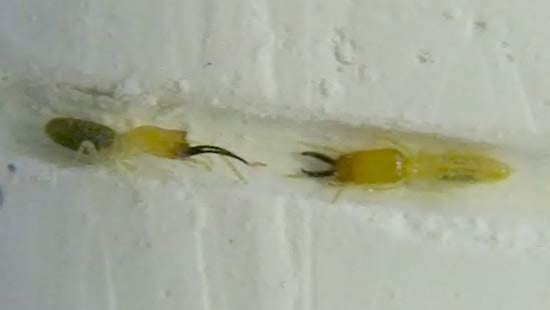The world's fastest termite bite
Panamanian is not only the fastest in the West, but worldwide. They can plug their jaws into the intruder at 157 mph (70 meters per second), destroying the enemy with a single bite.
Researchers need a high-speed camera of 40,000 frames per second to observe the attack of the termite's upper jaw.
Research team member Marc Seid, a postdoctoral researcher at the Smithsonian Tropical Research Institute, said: 'Many insects move faster than the human eye can see, so from the beginning we have know that high speed cameras are needed to observe their behavior. However we did not expect them to be so fast. '
Panamanian termites have the fastest known 'jaws' ever. This termite species needs such a fast attack ability to protect itself because its small size makes it difficult to create enough power to damage the enemy.
Jeryemy Niven, a member of the research team and postdoctoral researcher at STRI, said: 'To create a great impact force with a small object, you need to reach a very high speed'.
 A Panamanian termite attack invades its nest. Its upper jaw is the fastest in the world and can kill enemies with a single bite. (Photo: LiveScience)
A Panamanian termite attack invades its nest. Its upper jaw is the fastest in the world and can kill enemies with a single bite. (Photo: LiveScience)
Because worker termites face enemies in narrow tunnels and have very little space to hide and have little time to waste.This critical attack ability is particularly effective, although it can only be used at short distances.
.
Attack force is created by distorting the jaw. Their jaws clench until they strike. The strategy of concentrating energy from muscles to create ultrafast motion is also used by locusts, ants and cicadas.
Niven said: 'The termites need to focus energy to create a destructive force. They focus energy on the jaws but we still don't know by the way - that's the next question. '
Seid concluded: 'Basically, we are very interested in the brain evolution of workers and how they can use many different types of defenses'.
The study was published in the November 25 issue of Current Biology, conducted by the Smithsonian's neurobiological laboratory in Panama.
- The 'suicide bombing' of the termite species
- Giant clusters in Japan are making science surprising for this reason
- Essence is 'better than wood'
- The oldest 2,200-year-old termite mound on Earth
- Which animal is the fastest on the planet?
- Huge graveyard in Australia
- Myrmecophaga tridactyla
- Clash of giant termite species
- Decode the genetic genome of the termite
- Termites have the ability to detect gold mines in the ground
- Termites - the world's fastest creatures
- Why only 1 bite can cause blood infection to take one's life?
 'Fine laughs' - Scary and painful torture in ancient times
'Fine laughs' - Scary and painful torture in ancient times The sequence of numbers 142857 of the Egyptian pyramids is known as the strangest number in the world - Why?
The sequence of numbers 142857 of the Egyptian pyramids is known as the strangest number in the world - Why? History of the iron
History of the iron What is alum?
What is alum? How does chronic anxiety damage the heart?
How does chronic anxiety damage the heart?  What happens when a heart attack occurs?
What happens when a heart attack occurs?  The man saved the whole world from the Third World War 35 years ago
The man saved the whole world from the Third World War 35 years ago  8 most terrifying ground attack missiles
8 most terrifying ground attack missiles  Strength of 9 leading attack helicopters in the world
Strength of 9 leading attack helicopters in the world  Lion attack zebra
Lion attack zebra 